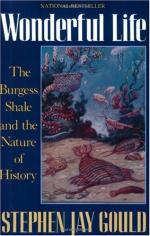
|
| Name: _________________________ | Period: ___________________ |
This test consists of 15 multiple choice questions and 5 short answer questions.
Multiple Choice Questions
1. What was Whittington's 1979 monograph written about?
(a) Dissecting Sanctocrabis.
(b) Monitoring Wiwaxia.
(c) Cataloging Marella splendens.
(d) Cataloging Opabinia.
2. Who was America's "greatest paleontologist and scientific administrator"?
(a) Charles Walmont.
(b) Charles Doolittle Walcott.
(c) Charlie VanGuarden.
(d) Dr. Doolittle.
3. How does Leif Størmer spread the Burgess arthropods among the groups in the arthropod phylum?
(a) Narrowly.
(b) Hardly.
(c) Widely.
(d) Minutely.
4. Which creatures are representative of these four classes that survived the first great extinction?
(a) Snails, crabs and dragonflies.
(b) Dragonfly, crabs, and trilobites.
(c) Dragonfly, a fossil eurypterid, a crab and a trilobite
(d) Eurypterid, mollusk, sea cucumbers.
5. What does Gould focus on to bring the Burgess Shale into clear view?
(a) Technical perfection
(b) Whittington's insight.
(c) Des Collin's insight.
(d) Opabinia's dissection.
6. What is so strange about Opabinia that paleontologists found it unbelievable?
(a) The proboscis.
(b) The function.
(c) The structure.
(d) The diagnosis.
7. What part did Whittington dissect of Opabinia?
(a) The head.
(b) The legs.
(c) The arms.
(d) The carapace.
8. What did Walcott think Opabinia was just another one of?
(a) Anemone.
(b) Mollusk.
(c) Crustacean.
(d) Plant.
9. What does the Precambrian Era contain?
(a) Rational, linear logic and the advent of single-celled life.
(b) Geological, non-biological time and the advent of single-celled life.
(c) Physical, non-linear time and the advent of multi-cellular life.
(d) Spatial, non-biological time and the decimation of single-celled life.
10. Who newly interpreted the Burgess animals in 1971?
(a) Dr. John Whit and his colleagues.
(b) Dr. Whittington of Yale and her husband.
(c) Professor Harry Whittington of Cambridge and his colleagues.
(d) Professor Matt Stephens and his wife.
11. What did the new methods Whittington and his team adopted help them do?
(a) Study the fossils.
(b) Recast the fossils.
(c) Transport the fossils.
(d) Organize the fossils.
12. Which fossils was Whittington an expert of?
(a) Bezoar fossils.
(b) Pitolimite fossils.
(c) Trixony fossils.
(d) Trilobite fossils.
13. What is the most common organism among the Burgess Shale fossils?
(a) Marrella splendens.
(b) Titilla splendens.
(c) Sanctocaris.
(d) Signi marella.
14. How much of all marine life died during the greatest extinction in history?
(a) 5%.
(b) 89%.
(c) 47%
(d) 96%.
15. How does Gould begin Chapter 2: "A Background for the Burgess Shale"?
(a) Explaining what the Burgess Shale represents.
(b) Explaining which animals are in the Burgess Shale.
(c) Explaining how scientists divide up historical epochs.
(d) Explaining the last chapter's conclusion.
Short Answer Questions
1. After publishing his first monograph, which two graduate students did Whittington employ?
2. Why did Whittington dissect Opabinia?
3. What are the evidences for Opabinia that are considered undeniable?
4. What was Whittington armed with that helped him review the claim that Opabinia was an arthropod?
5. How many specimens of Opabinia are in the Burgess Shale?
|
This section contains 490 words (approx. 2 pages at 300 words per page) |

|




